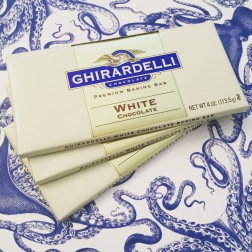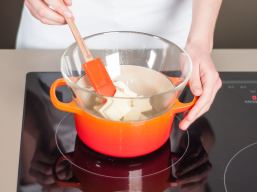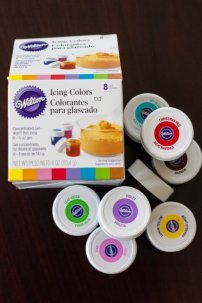
Cupcake or Bouquet? Does it even matter?
Ahh, spring. The season of sun-dappled days, refreshing evening breezes and, if you’re a woman with a pulse, festive celebratory showers!
Bridal Showers. Baby Showers. Virtual Showers. (Yes, it’s a thing) ‘Tis the season! Thankfully, as the sister of the amazing Science Chef, spring showers also bring the promise of freshly baked goodies and simply scrumptious bites.
This past weekend, we hosted a Bridal Shower for our soon-to-be sister-in-law. (Woohoo!) It was a lovely afternoon filled with coordinating pink-and-green decor, only slightly embarrassing games and, of course, food. As any veteran knows, pre-nuptial noshing can make or break the shower experience. Sad salads and measly morsels? Not at this soiree! The piece de resistance? Stunning bridal bouquet cupcakes made with love (and Food Science!) by my talented sister, Jane.
The light and fluffy vanilla cupcakes were, in themselves, a revelation. But the real star of the show was the vibrant white chocolate frosted flowers. Masterfully mixed. Perfectly piped. Expertly executed. There’s no question, the kid’s got talent, but there also happen to be some interesting Food Science facts hiding behind the floral facade.
Let It Be Known: All scientific knowledge and credit thereafter applied belongs to Jane Henry, Science Chef extraordinaire, and not to her sister, impressed bystander and cupcake consumer.
1. When melting chocolate, bar beats chip.

For this fabulous fete, tubs of Duncan Hines simply won’t do. No, no. That’s homemade white chocolate frosting you’re drooling over, folks. To get the smooth, creamy, dreamy consistency just right, Jane melted a Ghirardelli white chocolate bar rather than chips.
Why? Chocolate chips often contain paraffin, a colorless, soft solid derived from petroleum, coal or oil shale. (aka Wax) This paraffin helps chocolate chips hold their shape when baked under high heat in treats like cookies or cakes, but makes them less than ideal for melting down into ooey-gooey liquid gold.
A chocolate bar, on the other hand, does not contain paraffin. The melted result? Clump-free chocolate magma that begs to be swiped by a finger or two….or three.
2. If double boiling, avoid the splash!
 Jane’s preferred chocolate melting method is double boiling, which basically means melting the chocolate in a separate container nestled above a pot of hot water. This method, rather than the microwave alternative, allows for more temperature control. (Burnt chocolate is such a waste, no?)
Jane’s preferred chocolate melting method is double boiling, which basically means melting the chocolate in a separate container nestled above a pot of hot water. This method, rather than the microwave alternative, allows for more temperature control. (Burnt chocolate is such a waste, no?)
However, with this method, it is important to avoid a splash from the boiling bubbles below. If even a tiny bit of water finds its way into the melted chocolate, it will seize.
Sneeze? No, sieze. Chocolate contains, among other things, sugar and fat. Water molecules are not compatible with fat. They are, however, partial to sugar. (Who isn’t?) So, when a tiny bit of water gets into the melted chocolate, it will mix with the sugar crystals, causing them to become moist and cling together. Now you’ve got yourself an inhomogeneous (fancy vocab word that means “not the same”) mixture between the sugar and the fat. The result? Grainy chocolate and an unhappy chef.
3. For food coloring, let it gel.
Traditional food coloring – the kind that comes in those tiny color-coded squirt bottles – is made out of synthetic colorings with a water base. This option is easy to find, simple to use, and perfect for pastels. However, the high liquid level makes their color less intense. If bright hues are what you’re after, you’ll need to mix significantly more product into the frosting, which can sometimes lead to a soupy mess. 
For her elaborate flowers, Jane needed a sturdy frosting that would both keep its shape and visually pack a punch. Enter the gel!
Call it what you will – Gel Past Dye, Icing Color, Concentrated Gel – the proof is in the pudding. This type of food coloring, like the Wilton brand Jane used, is made out of synthetic colorings with a water, glycerine and/or corn syrup base. The mixture is more concentrated. As such, you need less of it to achieve poppy pinks, bold blues and gorgeous greens. Less food coloring = more frosting = happy campers!
These bridal bouquet cupcakes were almost too good to eat. (Almost) Although it hurt my soul to bite into those perfect petals, it had to be done. You know when something tastes so good, so out-of-this world amazing that mere mortal words just can’t do it justice? Well, I’ve coined a term for that – butterful – and let me tell you, these cupcakes were butterful.
Jane’s piping tricks? Nice try. But she is open for business and taking orders, so drop a line if you’re in the market for your next spring shower…or Friday night.

Jane and the beautiful Bride-To-Be!

The Cupcakes were a Masterpiece… Celebrating with Shades Of Summer…Coral Pink will Be The Color With A Pulse..!
LikeLike